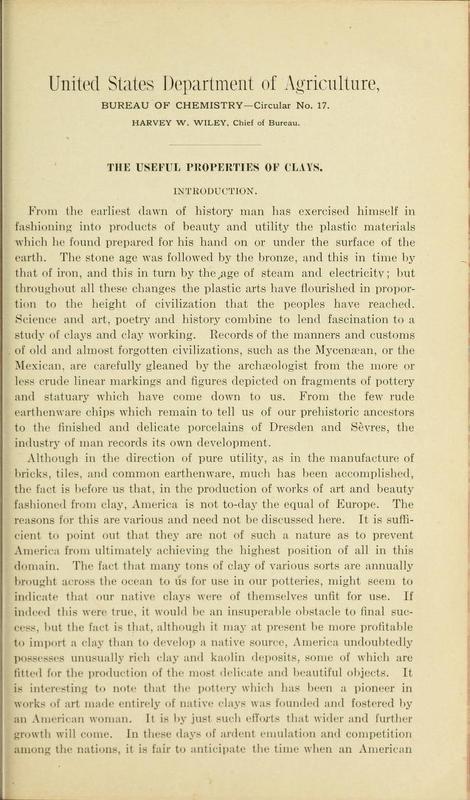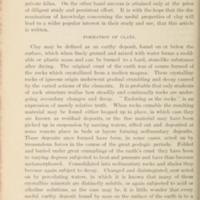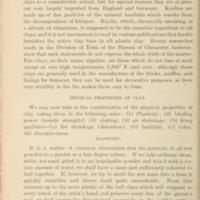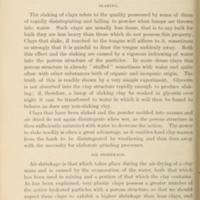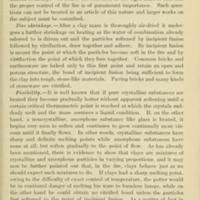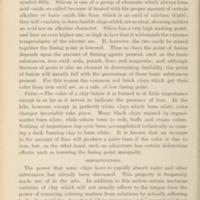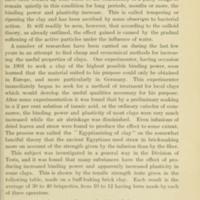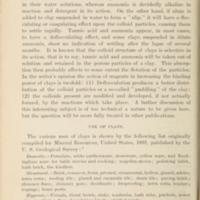The Useful Properties of Clays
Creator
Date
1904
Excerpt
From the earliest dawn of history man has exercised himself in fashioning into products of beauty and utility the plastic materials which he found prepared for his hand on or under the surface of the earth. The stone age was followed by the bronze, and this in time by that of iron, and this in turn by the age of steam and electricity; but throughout all these changes the plastic arts have nourished in proportion to the height of civilization that the peoples have reached. Science and art, poetry and history combine to lend fascination to a study of clays and clay working. Records of the manners and customs of old and almost forgotten civilizations, such as the Mycensean, or the Mexican, are carefully gleaned by the archaeologist from the more or less crude linear markings and figures depicted on fragments of pottery and statuary which have come down to us. From the few rude earthenware chips which remain to tell us of our prehistoric ancestors to the finished and delicate porcelains of Dresden and Sevres, the industry of man records its own development.
Although in the direction of pure utility, as in the manufacture of bricks, tiles, and common earthenware, much has been accomplished, the fact is before us that, in the production of works of art and beauty fashioned from clay, America is not to-day the equal of Europe. The reasons for this are various and need not be discussed here. It is sufficient to point out that they are not of such a nature as to prevent America from ultimately achieving the highest position of all in this domain. The fact that many tons of clay of various sorts are annually brought across the ocean to us for use in our potteries, might seem to indicate that our native clays were of themselves unfit for use. If indeed this were true, it would be an Insuperable obstacle to final success, but the fact is that, although it may at present be more profitable to import a (day than to develop a native source, America undoubtedly possesses unusually rich clay and kaolin deposits, some of which are fitted For the production of the most delicate and beautiful objects. It is interesting to note that the pottery which has been a pioneer in works of art made entirely of native (days was Founded and fostered by an American woman. It is by just such efforts that wider and further growth will come. In these days of ardent emulation and competition among the nations, it is fair to anticipate the time when an American name shall be added to those which stand for the highest achievement in ceramics, or the art of clay working. As soon as a greater number of individuals among our people become interested in the properties and possibilities of our native clay bodies, development is sure to follow. Clay working is neither so difficult nor so expensive but that in some eases objects of art have been molded in the home and burnt in private kilns. On the other hand success is attained only at the price of diligent study and persistent effort. It is with the hope that the dissemination of knowledge concerning the useful properties of clay will lead to a wider popular interest in their study and use, that this article is written.
Although in the direction of pure utility, as in the manufacture of bricks, tiles, and common earthenware, much has been accomplished, the fact is before us that, in the production of works of art and beauty fashioned from clay, America is not to-day the equal of Europe. The reasons for this are various and need not be discussed here. It is sufficient to point out that they are not of such a nature as to prevent America from ultimately achieving the highest position of all in this domain. The fact that many tons of clay of various sorts are annually brought across the ocean to us for use in our potteries, might seem to indicate that our native clays were of themselves unfit for use. If indeed this were true, it would be an Insuperable obstacle to final success, but the fact is that, although it may at present be more profitable to import a (day than to develop a native source, America undoubtedly possesses unusually rich clay and kaolin deposits, some of which are fitted For the production of the most delicate and beautiful objects. It is interesting to note that the pottery which has been a pioneer in works of art made entirely of native (days was Founded and fostered by an American woman. It is by just such efforts that wider and further growth will come. In these days of ardent emulation and competition among the nations, it is fair to anticipate the time when an American name shall be added to those which stand for the highest achievement in ceramics, or the art of clay working. As soon as a greater number of individuals among our people become interested in the properties and possibilities of our native clay bodies, development is sure to follow. Clay working is neither so difficult nor so expensive but that in some eases objects of art have been molded in the home and burnt in private kilns. On the other hand success is attained only at the price of diligent study and persistent effort. It is with the hope that the dissemination of knowledge concerning the useful properties of clay will lead to a wider popular interest in their study and use, that this article is written.
Title
The Useful Properties of Clays
File(s)
The Useful Properties of Clays 1.jpg
(image/jpeg)
The Useful Properties of Clays 2.jpg
(image/jpeg)
The Useful Properties of Clays 3.jpg
(image/jpeg)
The Useful Properties of Clays 4.jpg
(image/jpeg)
The Useful Properties of Clays 5.jpg
(image/jpeg)
The Useful Properties of Clays 6.jpg
(image/jpeg)
The Useful Properties of Clays 7.jpg
(image/jpeg)
The Useful Properties of Clays 8.jpg
(image/jpeg)
The Useful Properties of Clays 9.jpg
(image/jpeg)
The Useful Properties of Clays 10.jpg
(image/jpeg)
The Useful Properties of Clays 11.jpg
(image/jpeg)
The Useful Properties of Clays 12.jpg
(image/jpeg)
 An official website of the United States government.
An official website of the United States government.


